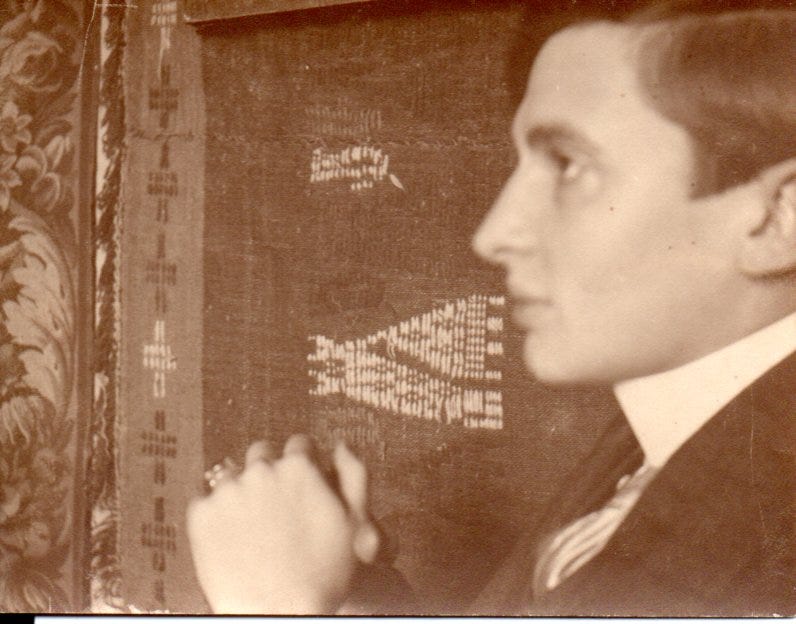Wolfgang Gurlitt - Art dealer
After the First World War, hopes for peace were disappointed. Economic hardship and unrest characterised the Weimar Republic. Yet Berlin's art scene flourished and reflected the upheavals.
Wolfgang Gurlitt in Rome in 1908 at the age of 20. Source: Private Archive. ©Alexandra Cedrino
My grandfather was many things: a glamourous art dealer. A passionate collector. An excessive lover who wanted to own what fuelled his passion. What he wasn't: simple. With the help of letters and the results of my research, I set out in search of him and found myself on a journey that would take me deep into German (art) history.
Wolfgang Ludwig Heinrich Carl Gurlitt was born in Berlin on February 15, 1888, the son of an art dealer who passed away at a young age, and died in Munich on March 26, 1965. He too became an art dealer, collector and publisher. Profited from Nazi art theft - although not to the same extent as his cousin Hildebrand Gurlitt. He didn’t like the Nazis, but still did business with them. He supported many of his friends who were in trouble. He could have done more.
There are stories about him. They are true and at the same time they are untrue. The truth lies somewhere in between. Some of these stories have inspired my own books.
Wolfgang Gurlitt is someone who doesn’t make things easy. He is difficult to grasp. His personality is made up of countless shades of black and white. And that is what makes him interesting.
Alice had imagined the villa in Potsdamer Strasse to be bigger, more magnificent. Perhaps it was the rain, which covered everything - the houses, the street, the trees, even the light - like a fine film and made it seem dull.
(from: Die Galerie am Potsdamer Platz)
I felt much like my main character Alice in “Die Galerie am Potsdamer Platz” when I set out a few years ago in search of the places associated with my grandfather Wolfgang Gurlitt.
I found some addresses in old directories: Potsdamerstraße 113, Matthäikirchplatz 7 and Matthäikirchstraße 27, Kurfürstenstraße 78. I came across a historical city map that I could use as a guide to find them. I also discovered photographs on the Internet of the two villas in Potsdamerstraße that served as my grandfather’s home and business premises.
As the addresses are in the part of Berlin that was reduced to ashes by Allied bombs during the Second World War, I didn’t expect to find much. Nevertheless, I wanted to give it a try. Maybe there was something left after all …
So on a cold and wet April day, I gathered my documents and took the underground west to Kurfürstenstraße. Chronologically, I started my search from the back. But as I had no great expectations anyway, that didn’t bother me.
And when I finally stood in front of the houses on Kurfürstenstraße and the empty and howling expanse of Matthäikirchplatz, my fears were confirmed. No matter how hard I tried to conjure up the ghosts of the past through the traffic noise, I couldn’t do it. Standing in the cold drizzle, I suddenly felt quite stupid. Had I really thought I could still discover something?
Downcast and frozen, I plodded down Potsdamerstraße and considered my voyage of discovery a failure when I finally reached the entrance to the courtyard of the former Tagesspiegel building. Did I really want to take a look into what was probably an equally dull and grey backyard? What the hell, I thought, now I’m here, I might as well have a look. I passed the showroom of a hat maker, turned into the driveway - and had a revelation.
There was a villa! No, two villas! The remains of an ensemble of six former buildings that seemed so lost, so completely out of time and out of touch with their surroundings, that you wanted to protect them from the new buildings around them. Stunned, I stared at the buildings marked by exhaust fumes, time and history.
I had found my grandfather …
In the upcoming blog posts, I will delve deeper into the story of Wolfgang Gurlitt and my family and also go into details that I used in my trilogy. I would be delighted if you would accompany me on these excursions.
Pictures of the villas (then and now) can be found on my blog (https://www.alexandra-cedrino.de/blog).
Until now my Galeristinnen trilogy (Die Galerie am Potsdamer Platz | Zeitenwende am Potsdamer Platz | Wiedersehen am Potsdamer Platz - all three published by Harper Collins Germany) is only available in German so far. So if you can read German, get them!



Alexandra- Thanks for bringing us along this journey into your grandfather’s marvelous past. I love that you knew your grandfather: simple. How wonderful to have the gift of observation into your own grandfather’s nature!
Very intriguing! I feel like we are there with you.